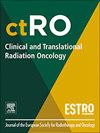Position in proton Bragg curve influences DNA damage complexity and survival in head and neck cancer cells
IF 2.7
3区 医学
Q3 ONCOLOGY
引用次数: 0
Abstract
Background and purpose
Understanding the cellular and molecular effect of proton radiation, particularly the increased DNA damage complexity at the distal end of the Bragg curve, is current topic of investigation. This work aims to study in vitro clonogenic survival and DNA damage foci kinetics of a head and neck squamous cell carcinoma cell line at various positions along a double passively scattered Bragg curve. Complementary in silico studies are conducted to gain insights into the link between cell survival variations, experimentally yielded foci and the number and complexity of double strand breaks (DSBs).
Materials and methods
Proton irradiations are performed at the HollandPTC R&D proton beamline, using a double passively scattered setup. A custom water phantom setup is employed to accurately position the samples within the Bragg curve. FaDu cells are irradiated at the proximal 36 % point of the Bragg peak, (P36), proximal 80 % point of the Bragg peak (P80) and distal 20 % point of the Bragg peak (D20), with dose-averaged mean lineal energies () of 1.10 keV/μm, 1.80 keV/μm and 7.25 keV/μm, respectively.
Results
Clonogenic survival correlates strongly with , showing similar survival for P36 (D37%=3.0 Gy) and P80 (D37%=2.9 Gy), but decreased survival for D20 (D37% = 1.6 Gy). D20 irradiated samples exhibit increased 53BP1 foci shortly after irradiation, slower resolution of the foci, and larger residual 53BP1 foci after 24 h, indicating unrepaired complex breaks. These experimental observations are supported by the in silico study which demonstrates that irradiation at D20 leads to a 1.7-fold increase in complex DSBs with respect to the total number of strand breaks compared to P36 and P80.
Conclusions
This combined approach provides valuable insights into the cellular and molecular effect of proton radiation, emphasizing the increased DNA damage complexity at the distal end of the Bragg curve, and has the potential to enhance the efficacy of proton therapy.
质子Bragg曲线位置影响头颈部肿瘤细胞DNA损伤复杂性和存活。
背景与目的:了解质子辐射的细胞和分子效应,特别是在布拉格曲线远端增加的DNA损伤复杂性,是当前研究的主题。本研究旨在研究头颈部鳞状细胞癌细胞系在双被动散射布拉格曲线不同位置的体外克隆存活和DNA损伤病灶动力学。进行了互补的硅片研究,以深入了解细胞存活变异,实验产生的焦点与双链断裂(dsb)的数量和复杂性之间的联系。材料和方法:质子辐照在HollandPTC研发质子束线上进行,使用双被动散射装置。一个定制的水幻影装置被用来精确地定位布拉格曲线内的样品。FaDu细胞在Bragg峰近36%点(P36)、近80%点(P80)和远20%点(D20)处辐照,剂量平均平均线能(y D¯)分别为1.10 keV/μm、1.80 keV/μm和7.25 keV/μm。结果:克隆生存与y D¯密切相关,P36 (D37%=3.0 Gy)和P80 (D37%=2.9 Gy)的生存相似,但D20 (D37%= 1.6 Gy)的生存降低。D20辐照后样品在辐照后不久53BP1病灶增加,病灶分辨率变慢,24 h后53BP1病灶残留较大,表明复合断裂未修复。这些实验观察结果得到了硅研究的支持,该研究表明,与P36和P80相比,D20照射导致复杂dsb的链断裂总数增加1.7倍。结论:这种联合方法为质子辐射的细胞和分子效应提供了有价值的见解,强调了Bragg曲线远端DNA损伤复杂性的增加,并有可能提高质子治疗的疗效。
本文章由计算机程序翻译,如有差异,请以英文原文为准。
求助全文
约1分钟内获得全文
求助全文
来源期刊

Clinical and Translational Radiation Oncology
Medicine-Radiology, Nuclear Medicine and Imaging
CiteScore
5.30
自引率
3.20%
发文量
114
审稿时长
40 days
 求助内容:
求助内容: 应助结果提醒方式:
应助结果提醒方式:


